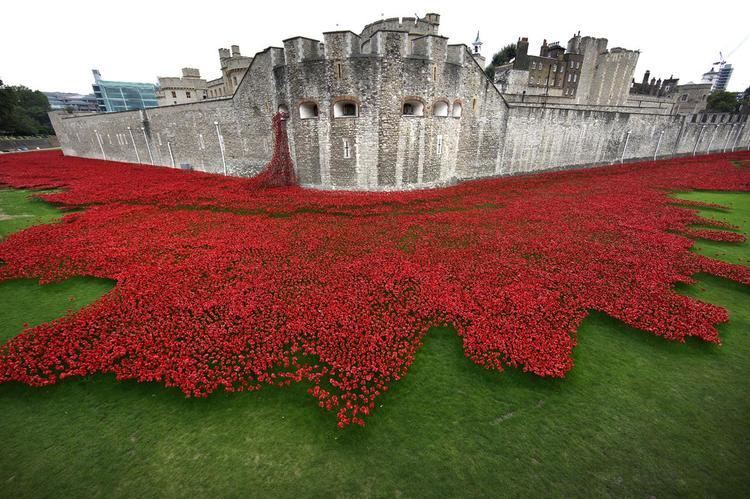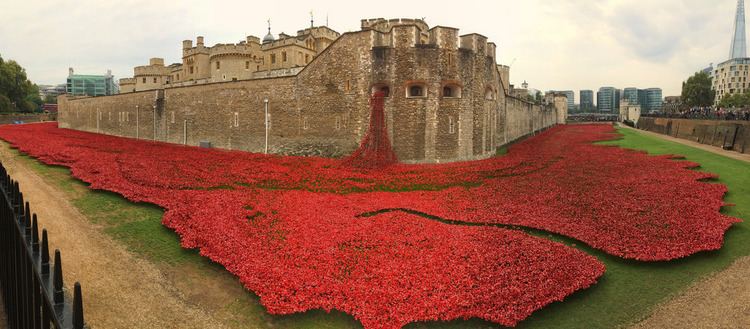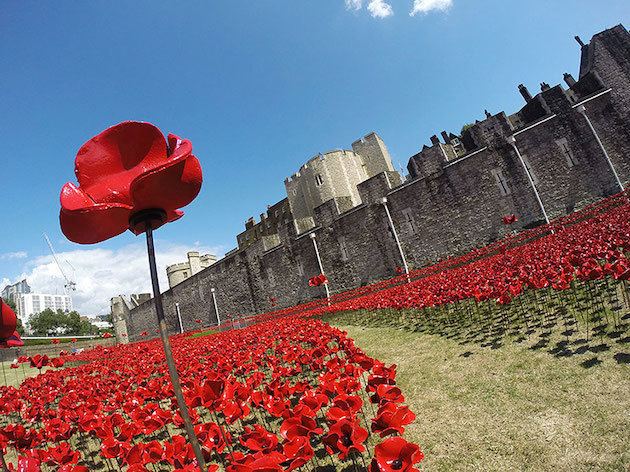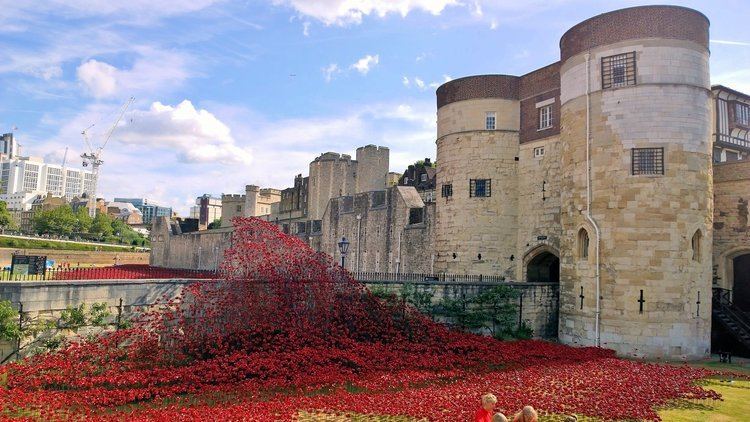Designed by Paul CumminsTom Piper | ||
 | ||
Established 17 July 2014 (2014-07-17) Unveiled 11 November 2014 (2014-11-11) Similar Animals in War Memorial, John F Kennedy Memorial, Christ Child, The Young Lovers, The Barbican Muse | ||
Blood Swept Lands and Seas of Red was a work of installation art placed in the moat of the Tower of London, England, between July and November 2014, commemorating the centenary of the outbreak of World War I. It consisted of 888,246 ceramic red poppies, each intended to represent one British or Colonial serviceman killed in the War. The artist was Paul Cummins, with setting by stage designer Tom Piper. The work's title was taken from the first line of a poem by an unknown World War I soldier.
Contents
- Poppies at the tower of london blood swept lands and seas of red
- Background
- Form
- Official visits and public reaction
- Critical reaction
- References

Poppies at the tower of london blood swept lands and seas of red
Background

The work's title, and Cummins' inspiration for the work, came from a poem by an unknown World War I soldier from Derbyshire, who joined up in the early days of the war and died in Flanders. The poem begins: "The blood swept lands and seas of red, / Where angels dare to tread / ... ". The poem was contained in the soldier's unsigned will, found by Cummins among old records in Chesterfield.
The Tower of London moat, in which the work was set, was used in the early days of the war as a training ground for City of London workers who had enlisted to fight – the "Stockbrokers' Battalion".
Form

The work consisted of a sea of ceramic red poppies, which were individually hand-made at Cummins' ceramics works in Derbyshire, and some at Johnson Tiles in Tunstall, Stoke-on-Trent. The poppies were added to the installation progressively by volunteers. The 497,000 kg of the Etruria Marl-based Etruscan red earthenware used, as well as the majority of the manufacturing equipment and materials, were supplied by Potclays Limited in Stoke-on-Trent There were eventually 888,246 of the flowers, representing one count of the number of British and Colonial military fatalities in World War I. The sea of flowers was arranged to resemble a pool of blood which appeared to be pouring out of a bastion window (the "Weeping Window").

The first poppy was planted on 17 July 2014, and the work was unveiled on 5 August (the centenary of Britain's entry into the war). A team of about 17,500 volunteers put the poppies in place. The last one was planted on 11 November 2014 (Remembrance Day), by a 13-year-old cadet, Harry Hayes, from the Combined Cadet Force (CCF) of Reading Blue Coat School. After that day a team of about 8000 volunteers began removing the flowers. Members of the public had been able to pre-order the ceramic poppies for £25 each, with a share of the proceeds (estimated at more than £15 million) going to six service charities: COBSEO, Combat Stress, Coming Home, Help for Heroes, the Royal British Legion and SSAFA.

At around sunset each day between 1 September and 10 November, the names of 180 World War I service personnel, nominated by members of the public to appear on a Roll of Honour, were read aloud by a Yeoman Warder, followed by the Last Post bugle call.
Official visits and public reaction
The installation was visited by the Princes William and Harry and the Duchess of Cambridge on the day of its opening, and by the Queen and Duke of Edinburgh on 16 October. The Queen later spoke about the memorial in her annual Christmas Message, broadcast on 25 December 2014.
In all, an estimated five million people saw the memorial, and the huge visitor demand saw Prime Minister David Cameron and other politicians join calls to try and extend the period for which the installation remained at the Tower so that more visitors would be able to pay their respects. Cummins and Tower officials resisted such calls, stating that the transience of the installation was a key part of the artistic concept, and that the poppies would be removed as planned and distributed to their purchasers. On 8 November it was announced that the Wave segment – a steel construction with poppies around the Tower entrance – would remain in place until the end of the month, and that the Wave and the Weeping Window segments (both made by the Theatre Royal, Plymouth) would be taken on a tour of the UK, organised by 14-18 NOW, lasting until 2018 and would then go on permanent display at the Imperial War Museums in London and Manchester. A campaign was launched in December 2014 to bring the sculptural elements to Stoke-on-Trent during the tour itinerary as the majority of materials and much of the piece itself were manufactured in the city. In April 2016, about halfway through the tour, the Weeping Windows segment was installed at St. Magnus Cathedral in Kirkwall, Orkney, Britain’s most northerly cathedral, to commemorate the 100th anniversary of the Battle of Jutland, the biggest naval engagement of the First World War.
In recognition of the work, Paul Cummins and Tom Piper were both awarded the MBE (Member of the Order of the British Empire) in the 2015 New Year Honours.
Critical reaction
Although the installation struck a chord with the public, it received negative reactions from some press critics. A. A. Gill of The Sunday Times called it "impressive" but "curiously bland". The Guardian's art critic Jonathan Jones described it as having a "false nobility" and being a "prettified and toothless" memorial. Tom Piper said in response that "... it is a remarkably good thing that it is so accessible. We should not be trying to create something that is difficult to understand."
